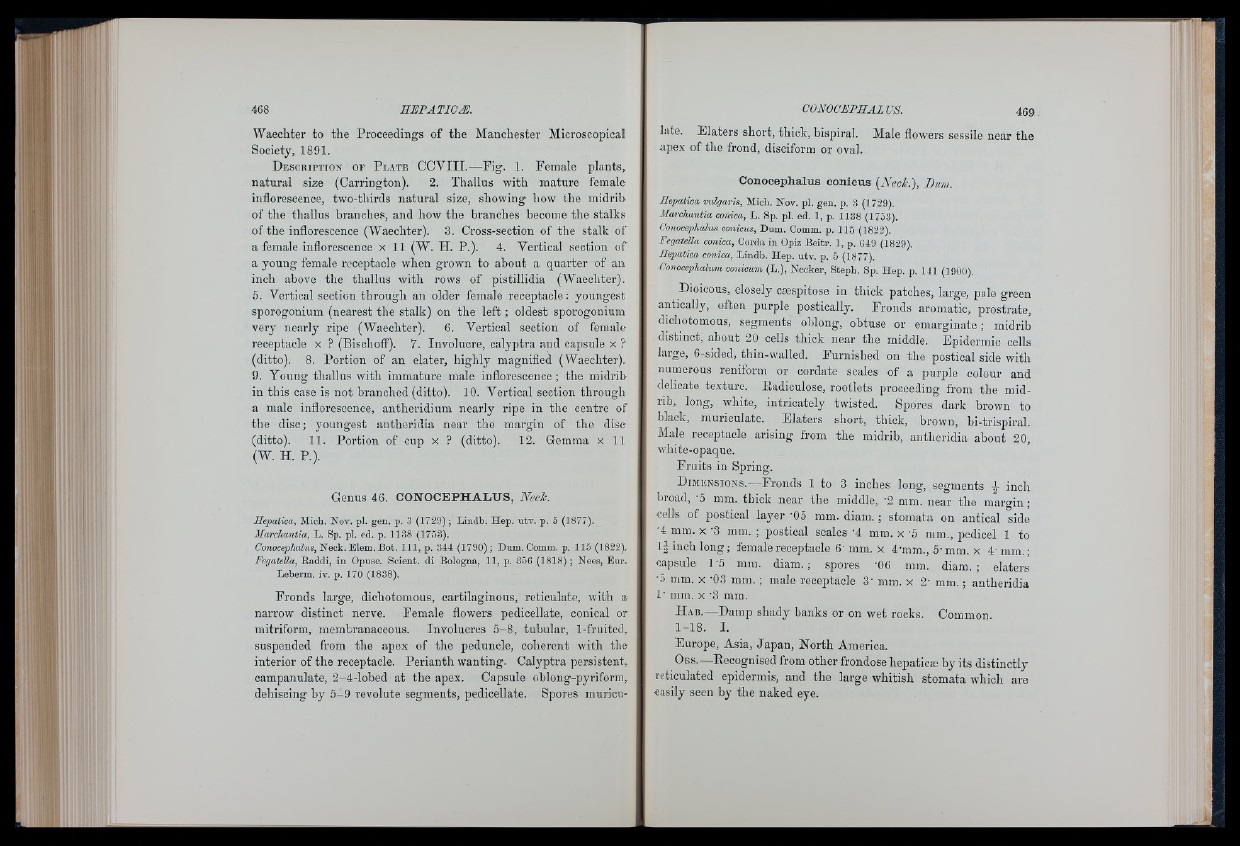
Waechter to the Proceedings of the Manchester Microscopical
Society, 1891.
D e s c r ip t io n oe P la t e CCVIII.— Fig. 1. Female plants,
natural size (Carrington). 2. Thallus with mature female
inflorescence, two-thirds natural size, showing how the midrib
of the thallus branches, and how the branches become the stalks
of the inflorescence (Waechter). ,3. Cross-section of the stalk of
a female inflorescence x 11 (W. H. P.). 4. Vertical section of
a young female receptacle when grown to about a quarter of an
inch above the thallus with rows of pistillidia (Waechter).
5. Vertical section through an older female receptacle: youngest
sporogonium (nearest the stalk) on the le f t; oldest sporogonium
very nearly ripe (Waechter). 6. Vertical section of female
receptacle x ? (Bischoff). 7. Involucre, calyptra and capsule x ?
(ditto). 8. Portion of an elater, highly magnified (Waechter).
9. Young thallus with immature male inflorescence; the midrib
in this case is not branched (ditto). 10. Vertical section through
a male inflorescence, antheridium nearly ripe in the centre of
the disc; youngest antheridia near the margin of the disc
(ditto). 11. Portion of cup x ? (ditto). 12. Gemma x 11
(W, H. P.).
Genus 46. CONOCEPHALUS, Neck.
Hepática, Mich. Nov. pi. gen. p. 3 (1729); Lindb. H ep. utv. p. 5 (1877).
Marchantía, L. Sp. pi. ed. p. 1138 (1753).
Goiioce^AaZits, Neck. Blem. Bot. I l l , p. 344 (1790); Dum. Comm, p. 115 (1822).
Fegatella, Eaddi, in Opuse. Solent, di Bologna, 11, p. 35C (1 8 1 8 ); Nees, Eur.
Leberm. iv. p. 170 (1838).
Fronds large, dichotomous, cartilaginous, reticulate, with a
narrow distinct nerve. Female flowers pedicellate, conical or
mitriform, membranaceous. Involucres 5-8, tubular, 1-fruited,
suspended from the apex of the peduncle, coherent with tlie
interior of the receptacle. Perianth wanting. Calyptra persistent,
campanulate, 2-4-lohed at the apex. Capsule oblong-pyriform,
dehiscing hy 5-9 revolute segments, pedicellate. Spores muriculate.
Elaters short, thick, hispiral. Male flowers sessile near the
apex of the frond, disciform or oval.
Conoeephalus conicus [Neck.), Bum.
Hepaliea vulgaris, Mich. Nov. pi. gen. p. 3 (1729).
Marchantía cónica, L. Sp. pl. ed. 1, p. 1138 (1753).
Conoeephalus conicus, Dum. Comm. p. 115 (1822).
Fegatella cónica. Corda in Opiz Beitr. 1, p. 049 (1829).
Ilepatica cónica, Lindb. Hep. utv. p. 5 (1877).
Conocephalum conicum (L,), Necker, Steph. Sp. Hep. p. 141 (1900).
Dioicous, closely cæspitose in thick patches, large, pale green
antically, often purple postically. Fronds aromatic, prostrate,
dichotomous, segments oblong, obtuse or emarginate; midrib
distinct, about 20 cells thick near the middle. Epidermic cells
large, 6-sided, thin-walled. Furnished on the postical side with
numerous reniform or cordate scales of a purple colour and
delicate texture. Eadioulose, rootlets proceeding from the midrib,
long, white, intricately twisted. Spores dark brown to
black, muriculate. Elaters short, thick, brown, bi-trispiral.
Male receptacle arising from the midrib, antheridia about 20,
white-opaque.
Fruits in Spring.
D im e n s i o n s .—Eronds 1 to 3 inches long, segments ¿ inch
broad, A mm. thick near the middle, ’2 mm. near the margin;
cells of postical lajær ’05 mm. diam. ; stomata on antical side
'4 mm. X -3 mm. ; postical scales '4 mm. x A mm., pedicel 1 to
1¿ inch long; female receptacle 6 'mm. x 4-mm., 5-mm.x 4-mm.;
capsule lA mm. diam.; spores '0 6 mm. diam.; elaters
A mm. X -03 mm. ; male receptacle 3 ’ mm. x 2' mm.; antheridia
1' mm. X -3 mm.
H a b .— Damp shady banks or on wet rocks. Common.
1-18. I.
Europe, Asia, Japan, North America.
O e s.— Eecognised from other frondose hepaticæ by its distinctly
reticulated epidermis, and the large whitish stomata which are
easily seen hy the naked eye.